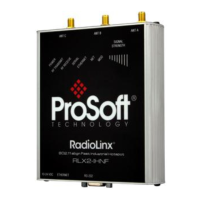RLX2 Series ♦802.11a, b, g, n Reference
Industrial Hotspots User Manual
ProSoft Technology, Inc. Page 125 of 161
May 8, 2013
The equipment shall be installed by a qualified installer/electrician. The
installer/electrician is responsible for obtaining a secured ground connection
between the lug terminal on the surge protector to a verified common ground
point using a minimum 6 AWG gauge wire. This must be done when attaching
power lines to the radio during installation.
A solid ground connection should be verified using a meter prior to applying
power to the radio. Failing to secure a proper ground could result in serious injury
or death as a result of a lightning strike.
Using Power over Ethernet (PoE) to power remote devices has several
advantages including:
"Carrier Class" Power Over Ethernet System.
Power can be supplied over long distances, up to 300 feet.
Power can be available wherever network access is available.
The power supply can be centrally located where it can be attached to an
uninterruptible power supply.
The user has the ability to easily power on reset the attached equipment from
a remote location.
There is no need to run additional power cabling to the device as power can
be supplied over the CAT5, CAT5E, or CAT6 Ethernet cable.
Used for remote mounted radios to save on cost of coax and reduce RF
losses.
Built-in Ethernet Surge protection to prevent equipment damage.
Overload and Short Circuit protection.
8.5.2 Ethernet Cable Specifications
The recommended cable is Category 5 or better. A Category 5 cable has four
twisted pairs of wires, which are color-coded and cannot be swapped. The
module uses only two of the four pairs when running at 10 MBit or 100 MBit
speeds. All eight wires are used when running at 1000 MBit speeds.
Category 5e or better cable is recommended for 1000 MBit speeds.
The Ethernet port on the module is Auto-Sensing. Use either a standard Ethernet
straight-through cable or a crossover cable when connecting the module to an
Ethernet hub, a 10/100/1000 Base-T Ethernet switch, or directly to a PC. The
module will detect the cable type and use the appropriate pins to send and
receive Ethernet signals.
Ethernet cabling is like U.S. telephone cables, except that it has eight
conductors. Some hubs have one input that can accept either a straight-through
or crossover cable, depending on a switch position. In this case, ensure the
switch position and cable type agree.
Refer to Ethernet cable configuration (page 126) for a diagram of how to
configure Ethernet cable.

